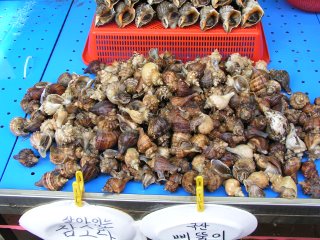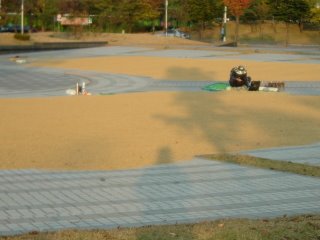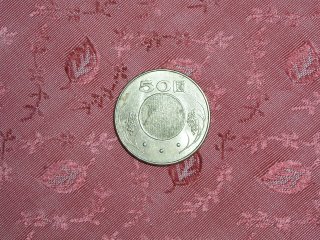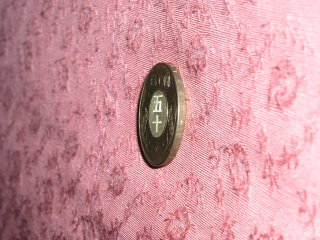Well, I've finally caught up on some of my posts in the works. Scroll down for some new entries that I've pre-dated.
My new apartuh (Korean speak) is much smaller than my old, but a bit closer to school, and much closer to the subway (which is basically outside my door). Unfortunately, I'm in the middle of an apartuh ghetto with very few markets or places to shop. Although there is a big shopping district not to far away, which even includes a western bar (basically, a bar where you can buy a drink without having to buy food as well).
From the open-air hallway that is outside my front door, I get a nice view of the local industrial park (notice that it snowed last night). 
From my back porch / laundry room, I get this lovely view. 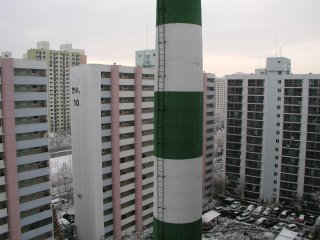
And the parking lot below. Which still has lots of room left. At night, cars are parked, double parked, and triple parked on every available piece of pavement. Watching cars maneuver in and out and night is a sight to behold.
Addendum: I've actually discovered the way of the parking lot - double parkers leave their cars in neutral, so if you're blocked in you can just push the offending car out of the way. 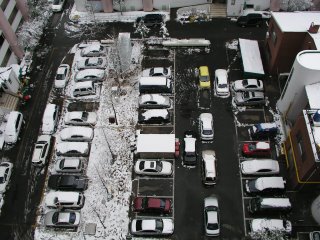
In remembrance of my travels, I plan on rolling out some top 10 lists by the end of the year. So look forward to my 10 most unpleasant travel experiences, my 10 best travel experiences, and my 10 places I most want to go.
Wednesday, December 6, 2006
The New Apartuh
Saturday, December 2, 2006
The bang
The bang (방), or room, is one of the crucial components of life in Korea. Because of Korea's high population density, apartments are usually too small to entertain your friends in. Especially when you still live with your parents at the age of 25. Thus, they have developed the bang. Say you want to hang out with your friends and play computer games. You go to the PC bang. If you want to hang out with your friends and sing songs, you go to the norae bang, or singing room. At the norae bang, you can rent your own private room and sing songs all night long. Both of these are more ubiquitous than grass here in the ROK.
Further more, there is the DVD bang, where you can rent a room and watch movies with your friends. Another bang of note is the jjimjil bang, which is the Korean hot bath and sauna house. This is where you'd go for a nice hot bath (very few apartments have baths) and, of course, the sauna. A final bang, which I've recently discovered, is the nori bang. Not to be confused with the norae bang, the nori bang is the children's playroom. This is where you can take your children, and for a few bucks, they can play inside. Perfect for the young mothers who worry about their kids playing in the street.
As you can see, the apartment is pretty much just a place to sleep. All other social activities take place outside of the home. And the bang is a crucial component to that social activity.
Sunday, November 26, 2006
T-Day
On my way home from work on Thursday, I realized it was Thanksgiving. So I stopped by one of the local chicken places and bought myself a chicken dinner. Unfortunately, they tend to sell family sizes, as in whole chickens. On the plus side, the do have a wide variety of flavors and breadings available. I settled with some sort of spicy chicken, which turned out to be a little too spicy and messy to truly enjoy. Nevertheless, I stuffed myself on chicken for Thanksgiving.
On Friday, the other foreign teacher at my school invited me to a Thanksgiving dinner that her husband's co-workers were having. They're all consultants for a pharmaceutical company here in Korea, and make a few more won than your average teacher. The person who hosted the party (high up on the food chain, so I hear) had one of the nicest apartments I've ever seen. A penthouse apartment with a roof top terrace. And the food was even better. Almost all of it was imported, via Costco (which they have in Seoul). Turkey, stuffing, mashed potatoes, gravy, salad. And no sweet pickles on the side. And that alone qualifies it as one of the best meals I've had in Korea (Note: sweet pickles some on the side of everything here. Even the Uzbek restaurant in Seoul serves sweet pickles on the side. Although, chicken is usually served with a side of pickled radishes.)
Wednesday, November 15, 2006
The Fish Market
Sunday, November 12, 2006
Ganghwa-do

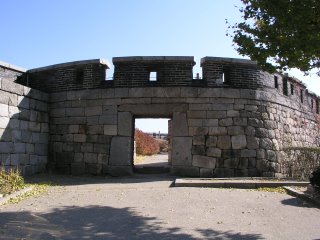 Just a short update to regarding my bicycle trip up to Ganghwa. Ganghwa, marked on the map above, is an island along the northwest coast of Korea. They have a lot of historic sites, but I just visited some of the old forts and batteries along the east coast. There's some more stuff on the island I'd like to see, but I'll wait until the weather starts to warm and the days start to get longer.
Just a short update to regarding my bicycle trip up to Ganghwa. Ganghwa, marked on the map above, is an island along the northwest coast of Korea. They have a lot of historic sites, but I just visited some of the old forts and batteries along the east coast. There's some more stuff on the island I'd like to see, but I'll wait until the weather starts to warm and the days start to get longer. 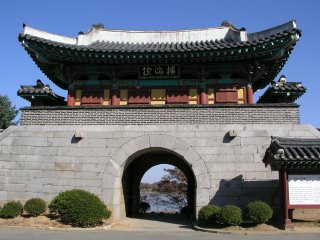 One of the most interesting aspects of the trip was the road along the coast from Incheon up to Ganghwa. As you may notice on the map, it is just down the coast from North Korea (the yellow line). So the ocean side of the road is lined with a couple of barbed wire topped, chain link fences, and guard towers all along the route.
One of the most interesting aspects of the trip was the road along the coast from Incheon up to Ganghwa. As you may notice on the map, it is just down the coast from North Korea (the yellow line). So the ocean side of the road is lined with a couple of barbed wire topped, chain link fences, and guard towers all along the route.
That's about it for the excitement here. I'm heading back down to the fish market tomorrow after work to get some more pictures. So stayed tuned.
Monday, October 30, 2006
Things you don't see in America
Sunday, October 29, 2006
A Day at the Market
Although they have plenty of super markets and department stores, there are still traditional markets in Korea. They remind me a little of the bazaars in Uzbekistan. But in Uzbekistan, the bazaar is pretty much the only place to buy groceries, so they're a lot more bustling. Still, the basics hold true. Every vendor has their own table with their specific products. So every item on your shopping list requires visiting a separate vendor. Here are some pictures of the traditional market down the street from my apartment. It's a small market, especially compared to some of the markets in Seoul. But it's also a lot less crowded.
The market is actually just a covered street
A fruit stand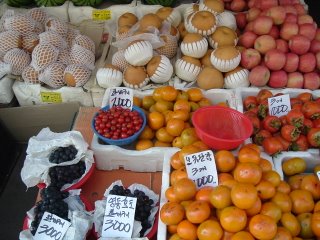
Rice, beans, and other dried stuff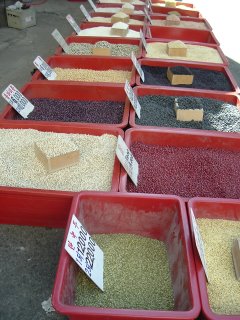
Green veggies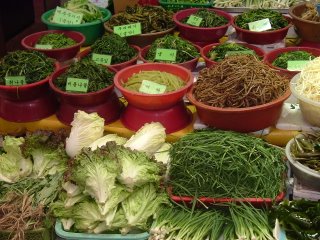
Fish
Smoked pig parts, or more specifically ham hocks and pig's feet. The bacon and pork is sold by a separate vendor
Korean salads. Uzbekistan has a large Korean exile population (thanks to the Soviets), so they always had a Korean salads section there too. 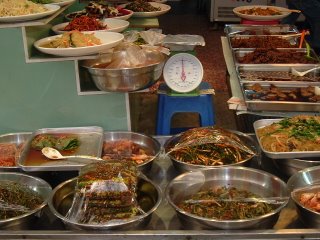
Dried fish, squid, and other sea creatures. 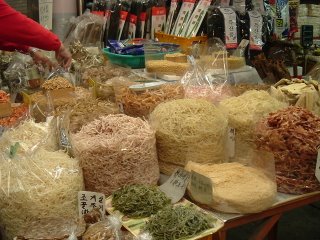
The ubiquitous red peppers. 
Thursday, October 26, 2006
New Discoveries
Not much to post about lately. I was going to write something about the North Korean nuclear test, but nobody e-mailed me with with their concerns for my safety, so I let it slide.
The one major addition to my life is my bike. I've been able to get my mileage (or rather kilometerage) up over the last few weeks. There is a so-so biking friendliness here. The new developments they're building usually have nice cushy material bike paths. The older areas of town usually have wide brick sidewalks with "bike paths" marked. Of course, you'll find more cars parked on the paths than people biking on them. Not to mention the pedestrians wondering to and fro on the bike path instead of in their appointed "lane". Paths also tend to have a lack of consistent curb access, and a lot of blind intersections (due to buildings or cars parked right up to the intersection). Biking on the street is okay, as the lanes are usually pretty wide and drivers are used to old men puttering down the street on their bikes. Of course, every time you get to a stop light everyone is so excited to make their right turns you're pretty much forced off the street. So you're stuck on the crummy sidewalks until you have the opportunity to reestablish a position. The older, more heavily populated areas of the city are frustrating to bike through due to crowded sidewalks, crowded streets, and lots of stoplight intersections. The intersections are made worse because they often don't allow two-way traffic going through them. Each directions takes their turn, so if you miss your chance to go through, you have to wait for all three other directions of traffic to cycle through. Although, I am getting better at blowing stop lights when there's no traffic. Fortunately, I'm on the south end of the busy part of Incheon. Unfortunately, if I want to take the ferry to the islands, I have to bike through a lot of this mess.
As of this week, I started riding to work. On Mondays, Wednesdays, and Fridays I go to work in the morning and bike straight home at night. It's just after sunset, so it's a tad dark. I'm actually more concerned about hitting a pedestrian than getting hit by a car. On Tuesdays and Thursdays, I have time to do a little more biking. I have a couple of nice uninterrupted (relatively) routes that I've found. One goes through an area which they are reclaiming from the sea. As of right now, it's just a 5 or 6 mile causeway out to this little island that is home to a few factories, a nice park, and a health club. There are fishermen up and down the causeway, and not much traffic on the road.  The second route I like takes me out of town, through a massive new development project - at least 20-30 large apartment buildings going up - past a little fishing port (with lots and lots of seafood restaurants), over the river, and down a very nice bike path for several miles. Once I reach the end of the path, I'm back on a busy street for a mile or so. I then divert off the busy road and pass through another port town, again with lots of seafood restaurants. Just past this port town is the farthest I've gone on this route. I've got two choices from there. A straight road along the coast that doesn't have any four way intersections, or a bridge / causeway that goes for about 12 miles out to an island. The bridge / causeway looks to have both a wide shoulder and separate sidewalk / bike path. So I'll probably explore that more on the weekend.
The second route I like takes me out of town, through a massive new development project - at least 20-30 large apartment buildings going up - past a little fishing port (with lots and lots of seafood restaurants), over the river, and down a very nice bike path for several miles. Once I reach the end of the path, I'm back on a busy street for a mile or so. I then divert off the busy road and pass through another port town, again with lots of seafood restaurants. Just past this port town is the farthest I've gone on this route. I've got two choices from there. A straight road along the coast that doesn't have any four way intersections, or a bridge / causeway that goes for about 12 miles out to an island. The bridge / causeway looks to have both a wide shoulder and separate sidewalk / bike path. So I'll probably explore that more on the weekend. 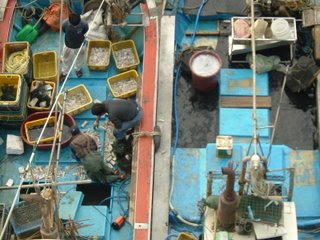 So this is a great way to see areas I wouldn't otherwise have gone to. For example, today I found a fish market at one of the port towns I biked through. I was checking out the area when I saw a large crowd going into a building. I went up to the door and saw that they had a trading floor, just like at the Merc. On a much smaller scale of course, but it was undeniably recognizable. A man in the middle of the "pit" had a box of fish spread out on the concrete floor. Around the pit, men and women crowded around shouting out bids. When the bidding ended, they scooped up the fish, put them back in the box, and gave them to the new owner. As I continued over the bridge, I saw an ever larger crowd on the river side of the building. Boats were being unloaded, and large crowds of people were buying and selling fish. The first picture above is of the market area from the bridge across the river. The second picture shows fishermen unloading their catches. I plan to head back next week with my good camera and get some more pictures of the trading pits and market.
So this is a great way to see areas I wouldn't otherwise have gone to. For example, today I found a fish market at one of the port towns I biked through. I was checking out the area when I saw a large crowd going into a building. I went up to the door and saw that they had a trading floor, just like at the Merc. On a much smaller scale of course, but it was undeniably recognizable. A man in the middle of the "pit" had a box of fish spread out on the concrete floor. Around the pit, men and women crowded around shouting out bids. When the bidding ended, they scooped up the fish, put them back in the box, and gave them to the new owner. As I continued over the bridge, I saw an ever larger crowd on the river side of the building. Boats were being unloaded, and large crowds of people were buying and selling fish. The first picture above is of the market area from the bridge across the river. The second picture shows fishermen unloading their catches. I plan to head back next week with my good camera and get some more pictures of the trading pits and market.
One late edition - a Google Earth picture of the places I talk about. I think the labels should be self explanatory. 
Monday, October 9, 2006
Korean Names 101
Korean names differ from what most people are used to. Instead of using given name and then family name, Koreans express their names as family name and then given name. Why, I'm not exactly sure. I believe it has something to do with the Confucius ethos. The family is more important than the individual. Just as addresses are written from general to specific, i.e. Starting with province, then city, urban area, neighborhood, building, and finally apartment.
Most Koreans outside of Korea adapt their name to the western convention, but a few keep the Korean style. One example would be Kim Jong-Il. He's not Mr. Il, but rather Mr. Kim. His given name is Jong-Il. For the soccer fans out there, you may know Manchester United midfielder Park Ji-Sung. He's not Mr. Sung, but Mr. Park.
Korean names usually have a specific format. But first, a brief explanation of Korean. Korean letters are arranged into patterns that resemble characters. In fact, these characters are composed of a quite limited set of letters. Each "character" represents one syllable. And that brings us back to Korean names. Family names are almost always one character. Kim, Lee, and Park being the most popular. In fact these three last names represent almost half of all Koreans. Within each family name, there are various clans. So people with the same name are only considered related if they are from the same clan. In fact, it was considered taboo to marry anyone within your own clan, no matter how distantly related. Although I've heard that restriction is being lessened. Everyone from the clan (or maybe it's just males) is entered into their family registry. Thus researching your ancestory is quite easy. Many of the clans can trace their ancestors back to the 1300s or earlier.
Next we have the given names. The given names are usually two characters or syllables, although I do have one student with just a one syllable given name. Some families still use a generational name, which is one syllable used with all children of that generation. For example, I have a brother and sister named Jin-Young and Ha-Young. But based upon my limited experience with my students, that isn't very frequent.
The greatest complication is the preponderance of similar names. The Kim, Lee, and Park problem is just the beginning. For some reason, almost everyone has one 'S' or 'J' syllable in their given name. Among 30 or so students and staff at my school, I can only count a handful without a 'S' or 'J' syllable. Permutations of 'S' syllables include Soo, So, Seo, Seh, Seul, Sun, Sung, Seung, and Sang. Among the 'J's, we have Jun, Joon, Jin, Ji, Jung, and Jae. Unfortunately, we don't give our kids Western names, so I'm constantly calling them by the wrong name or spelling their name wrong. And of course, they get upset when I misspell Seo as So.
One final point is the romanization of Korean names. Since Korean sounds don't exactly match English sounds, there is some debate as to how to romanize Korean. For example, the letter ㄱ (I'm not sure if Korean characters will show up on your computer or not) is pronounced somewhere between a hard 'g' and 'k'. In part, depending on where in the word it lies. So the name 김, which is almost always written as Kim, is closer to Gim. The name 박, or Park, should be written as Bak. And finally, 이, or Lee, is actually just a long e sound. So people with the same Korean name can romanize their names differently.
Sunday, October 8, 2006
Recipes
My favorite recipes. As opposed to having scraps of paper floating around my kitchen, I thought I'd put them here. Sources of recipes are available in the links.
Pancakes
I use a half recipe.
* 1 cup flour
* 1 1/4 tsp baking powder
* 1/4 tsp salt
* 1/2 egg, slightly beaten
* 3/4 cup milk
* 1 Tbsp melted butter
Combine dry ingredients, then add milk, egg, and butter. Mix and cook.
French Toast
I use a quarter of the given recipe.
* 1 egg
* 1/4 tsp sugar
* 1/4 tsp salt
* 1/4 c milk
* 3 slices of bread
Mix ingredients in a shallow pan. Coat bread with mixture. Cook.
Ice Cream
I simplify this recipe a bit and don't use eggs.
* 1 1/2 c cream
* 1 1/2 c milk (I like to use the flavored milk they sell here)
* 3/4 c sugar
Mix ingredients and put them in a container. Put in freezer. Stir every hour for several hours.
Plov
Ok, so I haven't made any plov (aka osh, the National Food of Uzbekistan) yet. But soon. I went to an Uzbek cafe in Seoul a few weeks ago with one of my Peace Corps alums. And the plov was a delightful alternative to the daily white rice staple they serve here.
Friday, October 6, 2006
The Search is Over
After a two week intensive search, I've finally found a stick of deodorant. At the grocery store three blocks from my house. While searching in Seoul a couple of weeks ago, I found a few places that carried deodorant. But the sticks were all quite small and ran $5 or $6. I finally resigned myself to paying this price but couldn't find any deodorant today when I went to Seoul. But there I was in the grocery store by my house when I finally spotted some deodorant and broke down and bought it. Same size and same price, but at least there's a nearby supply.
More importantly, I got a bike that actually fits. I bought a bike a few weeks ago which was a bit too small. I planned on getting the seat post modified to fit me better. But two days later it was swiped from the garage downstairs. I went back out bike shopping last week, but the biggest bikes I could find were still too small for me. After resigning myself to a bike free fall and winter, I found a bike listed for sale on one of the teacher's forums and I was able to snag it. It may be a couple of inches to small for me, but it's close enough.
My other major find today was a Sbarro's. The mall I went to had a Pizzeria Uno as well, but they wanted $15 for an individual pizza. Instead, I was able to get two good size slices of pizza from the Sbarro's for just over $7. Pepperoni and stuffed supreme. Very good. There are actually a lot of pizza places around me. Some have cheap $5-7 basic pizzas. They're not too bad, and I usually get one for for Friday dinner / Saturday breakfast. There are also the more expensive pizza joints (such as Domino's and Pizza Hut) which charge $20+ for a pizza. I've never tried them though. So to actually get western style pizza (i.e. no corn, lots of pepperoni) was a treat.
Saturday, September 16, 2006
The Information Age
As I am sitting here in my apartment in South Korea, I am watching English Premier League football (aka soccer to Americans) on the Al Jazeera network.
Friday, August 25, 2006
Birthday Bonanza
Today, we celebrated four birthdays at our school. Three from today, and one from Sunday. Quite a convergence for a school with only 25 students. The best part was seeing Korean culture in action.
First, Korean age must be explained. As in China (I believe), a child is born and assumes the age of one. At the Lunar New Year, they again age another year. So a child born at the end of the lunar year would end up being 2 years old pretty quickly. So like horses, all people age a year at the same time - on the Lunar New Year. So while we celebrated their western birthday, they actually don't age according to their Korean age. But on to the celebrations.
The first birthday celebration was for two of our pre-schoolers. Actually one pre-schooler and one kindergartner. But Koreans don't start public school until the first grade. The crucial point came when presents were passed out. It's considered rude (at least by some Koreans) to open presents in front of the giver. So while presents were passed out, none were opened. Just passed out and saved for later. After lunch, we went back to class, where I gave my (unwrapped) presents to my kids. I bought a bunch of stickers when I was in Taiwan, and I figured this was as good as time as any to pass them out. So I let the birthday boy and girl pick out a sheet of stickers. As I somewhat expected, the boy, who is 6 in Korean years (turning 5 in western age), picked a sheet of dinosaur stickers. Originally he thought he just got one sticker, so he was quite happy to get the whole sheet of them. And the first thing he did with them was to let the three other 6 years olds pick out a sticker for themselves. He's such a sweet little boy, and it was nice to see him sharing so well. I struggle with him daily to pay attention to the lesson, and with two new students coming next week, I'm pretty much resigned to letting him plug away at his coloring. At least he can keep himself occupied and doesn't cause problems for the other students.
The second celebration was for a couple of soon-to-be fourth graders. I've eaten with Koreans numerous times, but it's usually Korean food. When you delve into eating Western food with Koreans, it's like entering a whole new world.
First, they don't use knives. They use scissors. It's strange enough when they cut the meat at a Korean restaurant with scissors. It's down right freaky when they cut chicken or pizza with a pair of scissors.
Second, is the pickles. Next to the cabbage kimchi, the pickle is the most frequently appearing side dish. I detest both. I like cabbage. I like pickles. I like spicy food. But the Koreans somehow decided to make spicy cabbage and pickles which leave something to be desired. So while the pizza places always include pickles with my pizzas, I've never felt the need to add them to my pizza. Koreans feel otherwise. They love the side pickle, and make good use of it. Maybe I should bring all of my left over side pickle packets into school for the kids.
And finally, the all important chopsticks. Most Korean utensil sets include a pair of chopsticks and a spoon (for the omnipresent soup side dish). Again, it's not unexpected to see people eating Korean food with chopsticks. I use chopsicks whenever I eat Korean food. But to see kids using chopsticks to eat fried chicken is, well, just unsettling. At least they ate the pizza with their hands.
As the sites and sounds become mundane to me, I'm hoping to post more about Korean culture. Next up - Korean names, and why Americans get them all wrong.
Thursday, August 24, 2006
Monday, August 21, 2006
Around the World
This weekend, I saw the following...
Sacre Couer
Notre Dame de Paris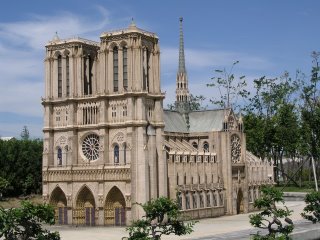
St. Peter's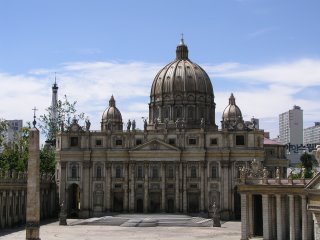
The Colosseum
The Great Wall of China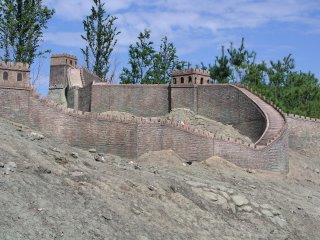
No, not some crazy around the world jaunt. But Aiins World, a land of miniature landmark recreations. Just how miniature? Here's how miniature. 
(And no, you aren't allowed to climb on them. Those are workers.)
Monday, August 14, 2006
Saturday, August 5, 2006
A Cool Coin
Wednesday, August 2, 2006
Taipei
The final stop on my trip was Taipei. I reversed my trip from Lugang to Chunghua, which was a little confusing due to the lack of any noticeable bus station in Lugang. After finding my disembarkment point, I waited for a bus and fortunately it looped back around to Chunghua. From there, it was back onto the train for another couple of hours. 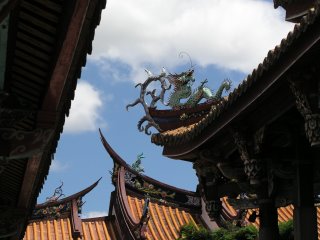 Taipei has a few interesting sights, but not quite the range of attractions that a city like Beijing has. There are the standard array of temples. The National Palace Museum houses a lot of Chinese art, which includes plates, bowls, vases, some jade carvings, bronze casts, and the occasional scroll. The best thing on display was a half room exhibit of ancient texts. The Chinese actually invented movable type in the 11th century, over 400 years before Gutenberg, who is given western credit for the invention.
Taipei has a few interesting sights, but not quite the range of attractions that a city like Beijing has. There are the standard array of temples. The National Palace Museum houses a lot of Chinese art, which includes plates, bowls, vases, some jade carvings, bronze casts, and the occasional scroll. The best thing on display was a half room exhibit of ancient texts. The Chinese actually invented movable type in the 11th century, over 400 years before Gutenberg, who is given western credit for the invention.  Shopping is plentiful, with numerous malls and underground shopping centers. One of the most interesting markets is actually outdoors. That is the Dihau market, which is a suitable replacement to the Lugang experience. You can buy pretty much anything you've never wanted to buy there. Big bags of dried flowers, herbs, roots, spices, and whatever else goes into the traditional Chinese medicine doctor's bag. I couldn't even recognize most of the stuff they were selling, which makes for quality cultural enrichment.
Shopping is plentiful, with numerous malls and underground shopping centers. One of the most interesting markets is actually outdoors. That is the Dihau market, which is a suitable replacement to the Lugang experience. You can buy pretty much anything you've never wanted to buy there. Big bags of dried flowers, herbs, roots, spices, and whatever else goes into the traditional Chinese medicine doctor's bag. I couldn't even recognize most of the stuff they were selling, which makes for quality cultural enrichment.
Probably the most interesting thing are the night markets. Considering the daytime heat, it's easy to see why night markets would be so popular. And the night markets in Taipei can approach a carnival like atmosphere. And the most carnivalistic, or carnivoristic one, as the case may be, is Snake Alley. There, you can find almost anything your heart desires. Of course there are snakes, which are charmed in front of restaurants as an attention getter. Handlers poke and prod the snakes to perform, and hopefully consume a rabbit or rat for the crowd. The snakes, for their part, seem to be content to rest. You can also find the expected rows of food carts and vendors hawking everything imaginable. As a bonus, they do in fact have carnival games available. Shooting games, throwing games, some mah jong based game that I couldn't figure out, fortune tellers, and a quite a few arcades that are filled with the everything from crane games, pop-a-shots, drumming games, to the latest Mortal Combat type games. 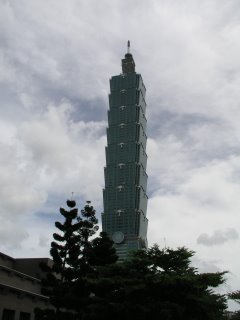 The last, and most modern of Taipei's experiences is Taipei 101. For now, at least, it is the world's tallest building. The draw is enhanced by the haute couture mall, an impressive food court, and a small, foreign goods filled grocery store that would be a welcomed addition to Korea. Going to the top costs NT350, which is about US$11. Which is the same amount as I was paying for my hostel room. Since I was trying to budget my expenses, I passed on the venture up. Instead, I had to content myself with making a small purchase to take home - tortilla shells and some pesto sauce packets. Besides, Taipei doesn't exactly have an impressive skyline to ogle. Taipei 101 is the only building that stands out from more than a few blocks away.
The last, and most modern of Taipei's experiences is Taipei 101. For now, at least, it is the world's tallest building. The draw is enhanced by the haute couture mall, an impressive food court, and a small, foreign goods filled grocery store that would be a welcomed addition to Korea. Going to the top costs NT350, which is about US$11. Which is the same amount as I was paying for my hostel room. Since I was trying to budget my expenses, I passed on the venture up. Instead, I had to content myself with making a small purchase to take home - tortilla shells and some pesto sauce packets. Besides, Taipei doesn't exactly have an impressive skyline to ogle. Taipei 101 is the only building that stands out from more than a few blocks away.
On Sunday, I caught the bus to the airport and made the 2 1/2 flight back to Incheon. And then spent 3 hours getting back to my apartment in Incheon. Let's just say I, and probably everyone in town, except the bus companies and taxi drivers, look forward to the extension of the subway out to the airport.
Overall, I found Taiwan a nice diversion from Korea. It, along with Korea and Japan, are considered the high pay teaching opportunities. So I'm keeping it as a possibility for sometime in the future. I'd prefer going to Japan, but I fear my expenses there would overwhelm me. At least for now, I'm happy with my situation in Korea. There are some aspects which are more enticing, and some that are less enticing. Chinese food a little more varied and palatable to me than Korean food (please, no more kimchi!), but I was sorely disappointed by their inability to make Kung Pao chicken (no pow to the Kung Pao). The language and characters are a definite downer, but I've discovered how quickly you can pick up the characters that you need. By the end of my trip, I was able to recognize the Chinese characters for Kung Pao chicken as well as fried rice.
This will probably, actually hopefully, be my last trip for a while. At least until winter break. In the meantime, I'll try to gather some interesting stories and pictures here in Korea.
Another view of Taipei 101. 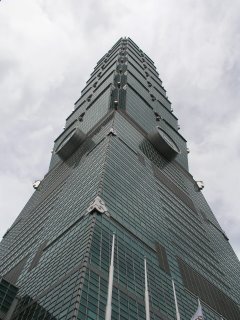
Tuesday, August 1, 2006
Lugang
I next hopped on the train from Tainan to Changhua, which is about half way between Tainan and Taipei. Trains leave almost every half hour and go up and down the coast at varying levels of urgency. The cost is quite reasonable - about US$10 for the two hour trip, while people under 115cm (just under 4 feet) get to ride for free. After getting off of the train in Changhua, I crossed the street and transferred to a rickety old bus that took me to the little town of Lugang. 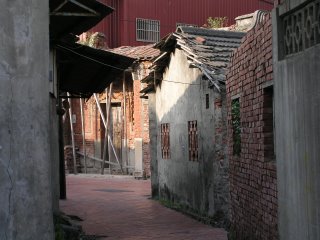 Lugang, or Lukang, depending on how you want to romanize it, has a history similar to that of Bruges, Belgium. Once an important port, the river silted up. Meanwhile, they prevented the railroad from passing through, leaving the town to age graceful into a rustic little historic anomaly. While Bruges has an overwhelming charm and character to it, Lugang is much less of an historic artifact. There are a few interesting old alleys, with quaint little houses and shops lining the walk. There are a couple of interesting temples. But after seeing the temples in Tainan, there's not much new left to see in the way of temple architecture. There are also numerous craft and art shops which line several old style streets. The wafting aroma of saw dust and lacquer and the handicrafts do provide some semblance of atmosphere, but crafts are not really my interest.
Lugang, or Lukang, depending on how you want to romanize it, has a history similar to that of Bruges, Belgium. Once an important port, the river silted up. Meanwhile, they prevented the railroad from passing through, leaving the town to age graceful into a rustic little historic anomaly. While Bruges has an overwhelming charm and character to it, Lugang is much less of an historic artifact. There are a few interesting old alleys, with quaint little houses and shops lining the walk. There are a couple of interesting temples. But after seeing the temples in Tainan, there's not much new left to see in the way of temple architecture. There are also numerous craft and art shops which line several old style streets. The wafting aroma of saw dust and lacquer and the handicrafts do provide some semblance of atmosphere, but crafts are not really my interest.
Even though the Taiwanese like to flock there, it's not really a must see destination for the foreign tourist. The narrow alleys of Taipei are just as interesting, albeit a little more congested and urban. Temples are everywhere in Taiwan. And if you're seriously into acquiring Chinese objets d'art, you'll go to mainland China, where the price would be a fraction of the cost that they are in Taiwan.
A small memorial in one of the old alleys
Ghost money - in addition to food, they also leave small plates of dried flower petals and ghost money. The ghost money is burned and used by the dear departed ancestors in the afterlife. 
Sunday, July 30, 2006
Tainan
I arrived at Chiang Kai-shek airport Saturday afternoon. Rather then making the venture into Taipei, which is about an hour away, in the other direction, I headed straight down the coast. After a 5 hour bus journey, including a 10 minute connecting layover in Taichung, I arrived in Tainan. Tainan is the oldest city in the country and was the capital of Taiwan from the 17th - 19th centuries. The inter-city buses were quite easy to use, and very comfortable. The first bus, to Taichung, had seats which were super plush. There was one seat on each side of the aisle, with big cushy arm rests, TV screens, with a movie playing (I think it was the Journey to the Center of the Earth remake, or something along those lines), and speakers, playing the original English dialogue, in the head rest. The second bus, from Taichung to Tainan, was a little less cozy, but still quite nice. It has three seats per row, and arm rests that weren't quite as La-Z-Boyish. But still, it was far superior to anything Greyhound has to offer. 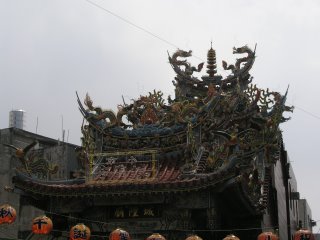 The main drawing points of Tainan are its old temples. Taiwan religion is a combination of Buddhism, Confucianism, Taoism, and folk religion. While the strictly Confucius temples are sedate, and resemble Korean or Japanese temples, the Taoist and folk influenced temples are extremely garish. Dragons and charactures line the roof tops. Inside, there is ornamentation galore, and a wide variety of gods represented. The most popular seems to be Matsu, the sea goddess. Other popular gods include the war god, the earth god, the god of heavens, and the city god.
The main drawing points of Tainan are its old temples. Taiwan religion is a combination of Buddhism, Confucianism, Taoism, and folk religion. While the strictly Confucius temples are sedate, and resemble Korean or Japanese temples, the Taoist and folk influenced temples are extremely garish. Dragons and charactures line the roof tops. Inside, there is ornamentation galore, and a wide variety of gods represented. The most popular seems to be Matsu, the sea goddess. Other popular gods include the war god, the earth god, the god of heavens, and the city god. 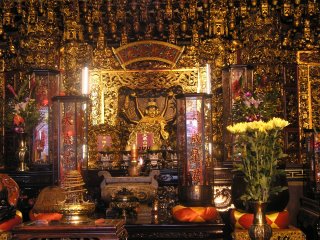 The layout of the temples differs from Japanese temples in other respects too. Japanese temples, and the few Korean temples that I've seen, usually have a multi-building layout, which is spread out over a small compound. There is an entry gate, a main hall, a lecture hall, a pagoda, a small pavilion for the bell, and an administration building. The Taiwanese temples, on the other hand, usually consist of one building, or a series of buildings all under one roof. There are successive altars along the central axis, with side chapels located in the passages between them. While some of the temples have open air courtyards, they are by and large an
The layout of the temples differs from Japanese temples in other respects too. Japanese temples, and the few Korean temples that I've seen, usually have a multi-building layout, which is spread out over a small compound. There is an entry gate, a main hall, a lecture hall, a pagoda, a small pavilion for the bell, and an administration building. The Taiwanese temples, on the other hand, usually consist of one building, or a series of buildings all under one roof. There are successive altars along the central axis, with side chapels located in the passages between them. While some of the temples have open air courtyards, they are by and large an
There are a couple of other attractions in Tainan, such as a couple of old Dutch forts. They are interesting, but not overly impressive. With less oppressive heat, and a couple of cab rides, everything could be covered in one long day. My only recommendation is that if you go to the Eternal Golden Castle, stop by the little drink stand across the street. One of the daughters working there is studying at the local university. She can speak English (and Japanese and of course Chinese) and will provide you with a seat in the shade while you wait for the bus, which only comes once an hour.
Something else that stood out were the sidewalks. Most of the sidewalks in Taiwan (or at least in the cities I visited) are covered by the buildings that line the street. Given the intense sun beating down, this is a good thing. Not so good is all the stores that push there display racks and restaurant seating out onto said sidewalk. So while you don't have to dodge scooters driving on the sidewalk, like in Korea, you do have shoppers and dinners to dodge. And with parked scooters usually aligned between the sidewalk and road, it's almost like an obstacle course making your way through town.
One further note - be forewarned of the automatic doors. They usually don't open until you are face to face with the sensor. So make sure you pause before you walk into the door.
Some of the dragons that populate most of the Taiwanese temples
A closer look at some of the temple roof details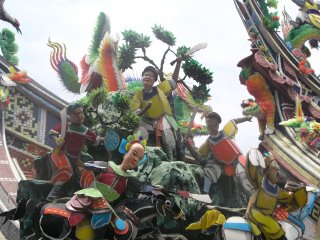
The inside ornamentation
This is where gifts of food are left. 




